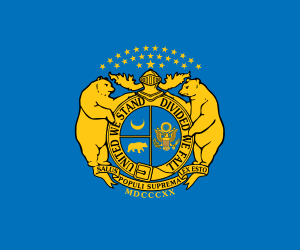Missouri Volunteer Militia
The Missouri Volunteer Militia (MVM) was the state militia organization of Missouri, before the formation of the Missouri State Guard in the American Civil War.
Prior to the Civil War, Missouri had an informal state militia that could be called up by the governor for emergencies or annual drill "in accordance with the Missouri State Statutes of 1854."[1] Larger militia elements, such as brigades or the element employed in the November 1860 Southwest Expedition of James Montgomery, were composed of independent regularly drilling volunteer companies, such as the St. Louis Grays, the National Guards, and the Washington Blues. Each of these companies wore its own distinctive, and highly ornate, uniform. Antebellum esprit de corps was enhanced by drill competitions among the independent companies.[2]
Secession
During the 1861 secession crisis, pro-secession Missourians sought to use the state militia to their advantage. On 13 February 1861, General Daniel M. Frost formed five new MVM companies composed entirely of pro-secessionist "Minutemen".
On 21 March 1861, the Missouri Constitutional Convention voted against secession, killing any possibility of secession by political action.
Governor Claiborne Jackson, a crypto-secessionist, then called up part of the MVM under Frost, and posted them just outside St. Louis, with the intent of seizing the city by force. This alleged plot was thwarted on 10 May 1861 when the MVM force was surprised and captured by unofficial Unionist Saint Louis Home Guard, a paramilitary arm of the Unconditional Union Party organized by Francis Preston Blair, Jr., and led by U.S. Army officers including Nathaniel Lyon, during the so-called Camp Jackson Affair.[3]
This shocking for secessionists act prompted the Missouri legislature to pass the "Military Bill" proposed by Governor Jackson, which gave the governor near-dictatorial control over the state militia, and reorganized it into the Missouri State Guard. On June 11, Governor Jackson met with Francis Preston Blair, Jr. and Nathaniel Lyon, who on Blair's suggestion was appointed by the U.S. War Department as Commander of the Western Department of the U.S. Army, at St. Louis' Planter's House Hotel to negotiate. A compromise was not reached and both sides afterwards blamed each other. On June 12, 1861, Governor Jackson issued a Proclamation to the State:
Now, therefore I, C.F. JACKSON, Governor of the State of Missouri, do, in view of the foregoing facts, and by virtue of the powers vested in me by the Constitution and laws of this Commonwealth, issue this, my proclamation, calling the militia of the State, to the number of 50,000, into active service of the State, for the purpose of repelling such invasions, and for the protection of the lives, liberties and property of the citizens of this State, and I earnestly exhort all good citizens of Missouri to rally to the flag of their State for the protection of their endangered homes and firesides, and for the defence of their most sacred rights and dearest liberties.[4]
Failure to restore the Price–Harney Truce conditions escalated tensions, and though the state of Missouri formally stayed in the Union, it became engulfed in guerrilla warfare and went through a series of bitter battles at the end of the Civil war.
See also
References
- Peterson, Richard C., McGhee, Kip A. Lindberg, and Keith I. Daleen. Sterling Price's Lieutenants: A Guide to the Officers and Organization of the Missouri State Guard, 1861-1865. Revised Edition. Shawnee Mission, Kans: Two Trails Pub, 2007, page 1, footnote 1.
- Field, Ron, and Richard Hook. The Confederate Army 1861-65: Vol.6 Missouri, Kentucky & Maryland New York, Osprey Publishing, 2008, pp. 3-6. ISBN 9781846031885
- The Battle of Wilson's Creek: The Camp Jackson Affairs, National Park Service
- June 12, 1861: Claiborne Fox Jackson’s proclamation
